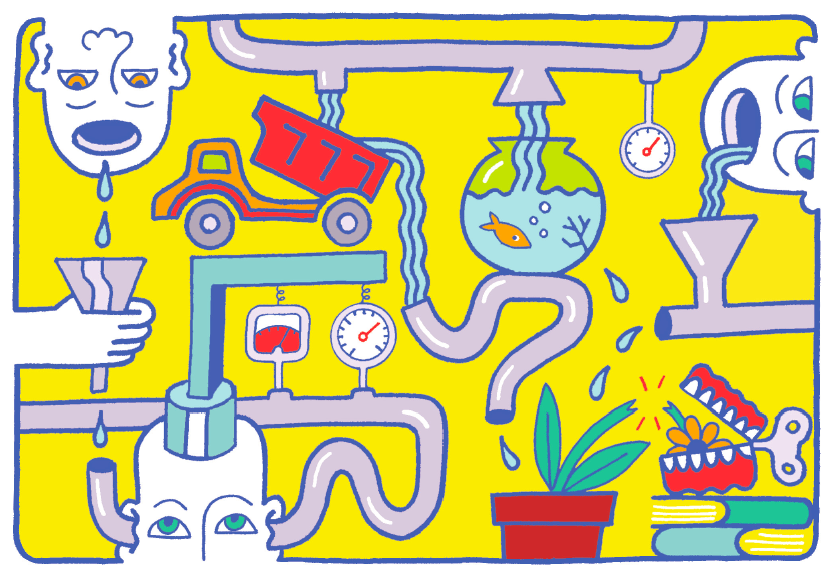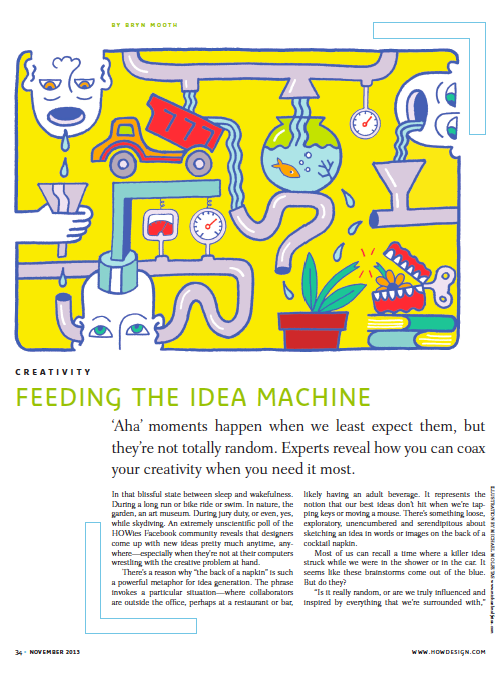Ever wonder why you come up with the best ideas when you’re not consciously trying to … like, in the shower or behind the wheel? (Me, I get my best ideas while I’m walking our dog).
It seems random, right?
Turns out, it isn’t random. I explored the serendipitous nature of idea-generation in a recent Creativity column for HOW. In researching the topic, I spoke with Sheri Gaynor, a Colorado-based registered expressive arts therapist, life coach and author of “Creative Awakenings: Envisioning the Life of Your Dreams Through Art.”
She told me that these unexpected ideas aren’t out of the blue at all — that they result from a sort of “simmering” process, as the brain subconsciously chews on a problem even when you’re not intentionally thinking about it.
In the column (click here or on the image below to view a PDF of the article), I spoke with other creative professionals about how they create the right conditions for ideas to emerge. A couple of key insights that may help your brainstorming process:
Feed the pot. If, as Gaynor told me, idea generation is a “simmering” process, then we need to add ingredients to the pot. I call these “inputs” — and they can be anything: research about a project, visual inspiration, cultural trends and other background. “Most ideas develop because problems need to be solved,” says Sunny Bonnell, coprincipal of the Myrtle Beach, SC, branding agency Motto. “For client work, I like to begin with research and discovery—researching the client, their purpose, trends, culture, vision, etc. It provides a strategic foundation, an intellectual output that can help drive the ideas behind the creative decision-making.”
Use tools to capture inputs and ideas. Serendipitous ideas are awesome. Forgetting them sucks. Brainstorms — and the inputs that feed them — can come anytime, anywhere. Keep notebooks in your gym bag, your glove compartment, your nightstand, your bathroom cabinet. Gaynor notes that your smartphone is your best idea-capturing tool. (I use Evernote‘s desktop and mobile apps to record ideas in words and images, as I’m out and about or online surfing the web.)
Build simmering time into your workflow. When you’re estimating or planning a design project, allow time for idea generation. Gaynor told me that creative blocks most often happen when we’re under pressure and that deadlines are the most frequent cause of pressure. Allow for inputs, then give yourself the time and space you need for ideas to bubble up.
What about you? When and where are you most likely to come up with great ideas? Please share your comments.


I met Sheri Gaynor several years ago and hd a few conversations with her. Your article reminded of what a wonderful and inspirational woman she is! While she might not know it, some of those conversations helped guide me while I was finishing up school and trying to find the footholds of my career…Metamorphosis! Thanks for sharing, Bryn! Such a great article!
Great ideas, I like to take a sketchbook outside, far from phones and computers. It’s crazy what Mother Nature will inspire for my high tech clients.
Erin, thanks for the comment! I find that taking our dog for a walk always jolts loose some ideas. I’ve “written” tons of content in my head while we’re out for a spin through the neighborhood. Getting away from the desk and out into the world is a great way to brainstorm.